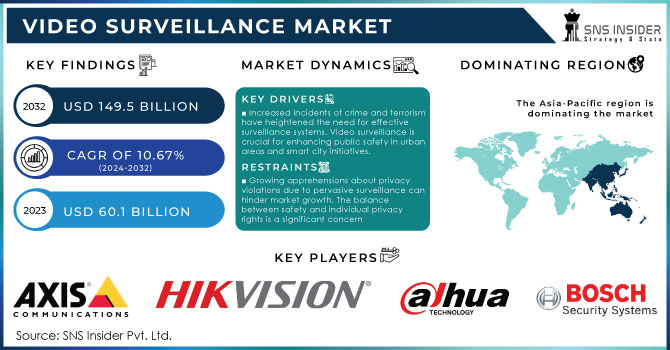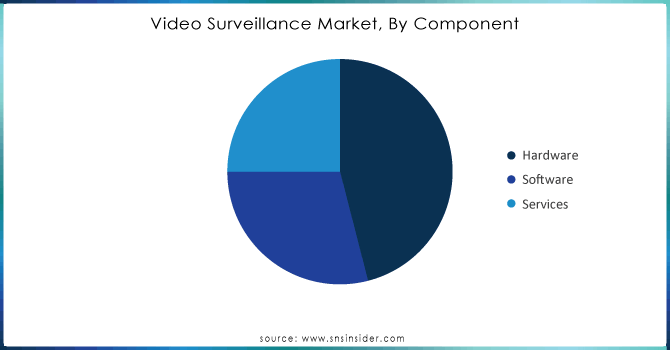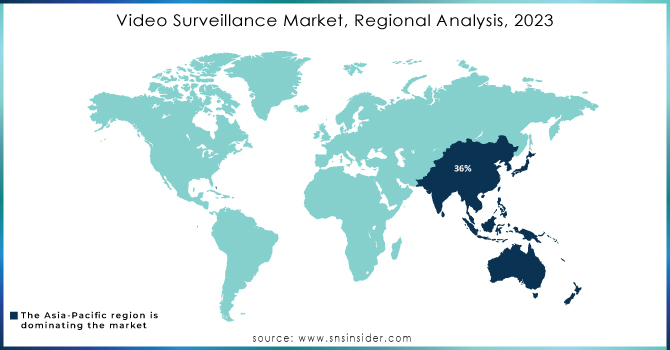Video Surveillance Market Size & Overview:

Get more information on Video Surveillance Market - Request Sample Report
Video Surveillance Market Size was valued at USD 60.1 Billion in 2023 and is expected to reach USD 149.5 Billion by 2032, growing at a CAGR of 10.67% over the forecast period 2024-2032.
The most prominent driver behind the growing trend of the video surveillance market is the increasing governmental initiatives to enhance public safety, prevent crime, and protect infrastructure. Security threats on a global scale, in the form of terrorism or the form of crime, have motivated many governments to implement advanced surveillance systems to monitor public and private areas as well as critical facilities. For example, in 2023, the U.S. government provided $2 billion to be spent on security technologies and video surveillance across federal buildings, airports, and other critical infrastructure. Similarly, the Safe Streets Fund set up by the U.K. Home Office, received £50 million in 2023 to focus on installing advanced CCTV cameras in high-crime areas to reduce street-level crime. In addition, increased use of video surveillance by domestic terror groups also drives growth.
According to the European Union, public initiatives of video surveillance have increased by 18% in the past five years in all European cities. The European Union endorsement constitutes the remaining leading force, ensuring governmental programs proceed to the same extent in other regions. Smart city programs are driving demand for intelligent video solutions in conjunction with AI-based analytics and ensure heightened situational awareness along with automated responses to security threats. China’s Ministry of Public Security reported in 2023 that over 600 million surveillance cameras have been installed in the country, and the system has been further incorporated with AI technologies, for better comprehensive monitoring of urban management and public safety. Thus, governments’ increased interest in the growth of national security through effective surveillance, as well as increased use of video surveillance in law enforcement and local security, ensure the continuous and sustainable growth of the video surveillance market.
In addition, the need to monitor remotely and access the surveillance feed in real-time, as well as regulatory requirements for improved security measures, are driving demand. In all sectors, demand for video surveillance is growing as it is integrated with other systems such as access control and the Internet of Things. The market’s growth is driven by the need for security in schools, airports, businesses, or homes and the demand for both private and public. Intelligent video surveillance is required to monitor all activities in the emergence of smarter cities. Cloud-based systems appear to be gaining popularity due to their scalability and low cost.
Video Surveillance Market Dynamics
Drivers
- Increased incidents of crime and terrorism have heightened the need for effective surveillance systems. Video surveillance is crucial for enhancing public safety in urban areas and smart city initiatives.
One of the prominent drivers of the video surveillance market is increasing security concerns resulting from growing crime rates and terrorist attacks. As public safety becomes the primary concern for people, governments and organizations are employing sophisticated surveillance systems. For example, based on a survey conducted by the National Institute of Justice, more than 60% of law enforcement agencies reported an increase in violent crime and a high demand for technology to prevent aggressive actions. Furthermore, numerous cities across the world are deploying smart surveillance solutions. For instance, in 2023, the video surveillance system was powered by AI and implemented in the city of Los Angeles. This city camera network complements existing infrastructure and ensures 24/7 real-time monitoring and quick response to events. The primary goal of this initiative is to decrease crime rates and enhance emergency services’ efficiency. Correspondingly, according to a recent report, around 54% of customers noted that they demonstrated more interest in recognizing public cameras. Overall, both public and private sectors acknowledge the value and potential of surveillance systems. As a result, such a tendency drives investments to maintain and enhance video surveillance as the most effective solution to maintaining people’s safety.
-
Innovations in AI, machine learning, and video analytics have improved the capabilities of video surveillance systems, allowing for features like real-time monitoring, object recognition, and behavioral analysis, which enhance both security and operational efficiency.
-
The push towards developing smart cities involves extensive use of video surveillance to monitor traffic, ensure public safety, and improve emergency response, significantly driving market demand.
Restraints
- Growing apprehensions about privacy violations due to pervasive surveillance can hinder market growth. The balance between safety and individual privacy rights is a significant concern
One significant restraint in the video surveillance market is related to concerns about privacy. With the ever-increasing presence of surveillance technologies, the public has become more and more alarmed about the possible infringement of privacy. Given that surveillance cameras can be configured to record continuously, people inherently feel that they are being watched. It raises concerns about governments using them to gain excessive control or selling the information acquired to make profits. This issue is supported by numerous cases of data breaches and footage misuse that have been publicized in recent years. As such, customers or businesses may resist the adoption of new surveillance solutions due to the fear of violating individual rights. Additionally, regulatory frameworks around data protection, such as GDPR in Europe, impose strict guidelines that companies must adhere to, adding complexity to compliance and implementation.
- The initial investment for advanced video surveillance systems, including installation and maintenance, can be prohibitively high for smaller businesses or residential users
Video Surveillance Market Segment analysis
By System Type
In 2023 the market was dominated by the IP video surveillance systems segment which contributed to more than 53% of total revenue. This can be explained by the rising adoption of IP systems instead of traditional analog solutions due to their increased capabilities. It offers higher-resolution video, increased power of analytics such as face recognition and object detection, and the ability of remote monitoring, which makes it suitable for implementation in various areas of the public and private sectors. In addition, governments are enforcing regulations to stimulate the switch from analog to IP systems all over the world. In 2023 the Ministry of Urban Development of India declared the requirement that all new monitoring systems in the public areas should be IP, which led to the significant increase in demand for these systems. Moreover, IP solutions are easily integrated into the It infrastructure of the organization and allow for centralized monitoring from multiple locations, which further drives its implementation in the commercial, governmental, and industrial sectors.
By Component
The hardware segment dominated the market and held over 69% of the market revenue in 2023, with hardware including cameras, monitors, storage devices, and others, produced. The market share of the segment is significant largely due to the high demand for surveillance cameras, which are the foundation of video surveillance systems. Governments across the globe make huge investments in the deployment of surveillance cameras to enhance the monitoring of public spaces and critical infrastructure. For example, in 2023, the Ministry of Public Security of China announced that 20 million new high-resolution surveillance cameras were deployed under the nationwide “Sharp Eyes” initiative. Moreover, the technological progress in camera hardware, including 4K resolution, night vision, and thermal imaging, is playing a part in the rising demand for modern surveillance equipment. Therefore, in 2023, as reported by the U.S. Department of Homeland Security, 78% of new surveillance projects sponsored by the federal government involved the acquisition of modern hardware components, such as high-definition cameras and sophisticated storage systems to ensure permanent, secure data retention.

Need any customization data on Video Surveillance Market - Enquiry Now
By Vertical
In 2023, the commercial sector led the video surveillance market, accounting for over 36% of global revenue. The growing need for enhanced security in commercial establishments such as retail stores, offices, hotels, and entertainment venues has driven the demand for advanced video surveillance systems. Governments have introduced various regulations requiring commercial businesses to install surveillance systems for both safety and compliance purposes. In the U.S., the Department of Justice implemented new guidelines in 2023 requiring commercial establishments in high-crime urban areas to deploy 24/7 video surveillance to prevent criminal activities.
The commercial sector takes the leading position in the video surveillance market in 2023, accounting for over 36% of global revenue. With the rising concerns over the safety and security of commercial establishments, such as retail, offices, hotels, and entertainment places, the need for advanced video surveillance systems has driven the development. In response to the ever-rising complexity and risks within commercial domains, governments have introduced multiple regulations and standards obligating commercial businesses to install surveillance systems for their safety and compliance purposes. In the U.S., the Department of Justice introduced its new guidelines in 2023, which require all commercial establishments operating in high-crime, urban areas to deploy video surveillance 24/7 to curb criminal activities.
The commercial vertical has adopted advanced video surveillance systems, powered by AI to enhance operational efficiency and provide insight into customer behavior, which has also propelled its growth. Facing multiple business-critical challenges in the form of protecting expensive assets, mitigating risks, and ensuring safety and security, the commercial vertical is expected to continue driving the video surveillance market.
Regional Insights
In 2023, the Asia-Pacific region maintained its leadership in the global video surveillance market, with a market share of 36%. The primary reason for such dominance is the large-scale deployment of surveillance systems in such countries as China and India. These activities have been boosted by various governmental smart city programs and public security initiatives. For instance, the “SkyNet” program initiated by the Chinese government to monitor smart cities using AI-based surveillance cameras increased the market share of the Asia-Pacific up to 60% in 2023. In this case, China specifically exceeded APAC’s market share as the Ministry of Public Security reported that it installed more than 600 million surveillance cameras by the end of 2023.
In North America, the regional level of video surveillance deployment has grown at the fastest CAGR due to the significant increases in governmental investments in the modernization of the security infrastructure. The U.S. Department of Homeland Security's focus on securing critical infrastructure and public spaces led to a market share of 28% in 2023. It is expected that the application of AI solutions to be deployed in smart city programs will contribute to the even greater growth rate of the region.

Key Players
Key Manufacturers/Service Providers
-
Axis Communications (AXIS P5635-E PTZ Network Camera, AXIS Q6215-LE Network Camera)
-
Hikvision (DS-2CD2087G2-L, DS-2DE4A425IW-DE)
-
Dahua Technology (N52A2P, DH-IPC-HDW5831R-ZE)
-
Bosch Security Systems (AUTODOME IP starlight 7000i, DINION IP 5000i)
-
Hanwha Techwin (QNP-6320R, PNV-A9081R)
-
FLIR Systems (FLIR FX, FLIR DNR-SL)
-
Honeywell Security (Honeywell Fusion, Performance Series Cameras)
-
Tyco Integrated Security (Tyco Illustra Flex, Tyco 3 Series Cameras)
-
Motorola Solutions (Avigilon H4 Multisensor Camera, Avigilon Control Center)
-
Genetec (Security Center, Genetec Clearance)
Key Users of Video Surveillance Services/Products
-
Walmart
-
Amazon
-
Bank of America
-
Target
-
McDonald's
-
University of California
-
FedEx
-
MGM Resorts International
-
City of Los Angeles
-
Houston Police Department
Recent Developments
-
In March 2024, the U.S. Department of Defense announced a $1.5 billion investment over the next five years in the upgrade of its video surveillance infrastructure across its bases and sensitive sites to enable real-time monitoring.
-
In April 2024, the South Korean Hanwha Vision Co., Ltd. and US-based Allied Telesis, Inc. partnered to boost the compatibility and security of their systems with a comprehensive physical security solution, simplifying the management of networks and IP cameras for security applications.
-
In April 2024, Hangzhou Hikvision Digital Technology Co., Ltd. unveiled its new Turbo HD 8.0 two-way audio cameras designed for instant human communication, with applications including Intercoms and security fencing.
-
In February 2024, Zhejiang Dahua Technology Co., Ltd. collaborated with Clear Digital, a New Zealand firm, to expand its market presence and deliver improved IP surveillance hardware and video management software in the area.
| Report Attributes | Details |
|---|---|
| Market Size in 2024 | USD 60.1 Billion |
| Market Size by 2032 | USD 149.5 Billion |
| CAGR | CAGR 10.67% From 2024 to 2032 |
| Base Year | 2022 |
| Forecast Period | 2024-2032 |
| Historical Data | 2020-2022 |
| Report Scope & Coverage | Market Size, Segments Analysis, Competitive Landscape, Regional Analysis, DROC & SWOT Analysis, Forecast Outlook |
| Key Segments | • By Component (Hardware, Software, Service) • By System (IP Video Surveillance Systems, Analog Video Surveillance Systems, Hybrid Video Surveillance Systems) • By Vertical (Commercial, Industrial, Residential, Government) |
| Regional Analysis/Coverage | North America (US, Canada, Mexico), Europe (Eastern Europe [Poland, Romania, Hungary, Turkey, Rest of Eastern Europe] Western Europe] Germany, France, UK, Italy, Spain, Netherlands, Switzerland, Austria, Rest of Western Europe]), Asia Pacific (China, India, Japan, South Korea, Vietnam, Singapore, Australia, Rest of Asia Pacific), Middle East & Africa (Middle East [UAE, Egypt, Saudi Arabia, Qatar, Rest of Middle East], Africa [Nigeria, South Africa, Rest of Africa], Latin America (Brazil, Argentina, Colombia, Rest of Latin America) |
| Company Profiles |
Axis Communications, Hikvision, Dahua Technology, Bosch Security Systems, Hanwha Techwin, FLIR Systems, Honeywell Security, Tyco Integrated Security, Motorola Solutions, Genetec |
| Key Drivers | •Increased incidents of crime and terrorism have heightened the need for effective surveillance systems. Video surveillance is crucial for enhancing public safety in urban areas and smart city initiatives •Innovations in AI, machine learning, and video analytics have improved the capabilities of video surveillance systems, allowing for features like real-time monitoring, object recognition, and behavioral analysis, which enhance both security and operational efficiency. •The push towards developing smart cities involves extensive use of video surveillance to monitor traffic, ensure public safety, and improve emergency response, significantly driving market demand |
| Market Restraints | •Growing apprehensions about privacy violations due to pervasive surveillance can hinder market growth. The balance between safety and individual privacy rights is a significant concern •The initial investment for advanced video surveillance systems, including installation and maintenance, can be prohibitively high for smaller businesses or residential users |

